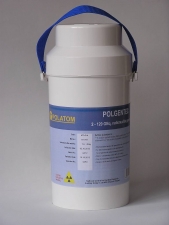A new Tc-99m production line will soon start operations in Świerk
04-02-2015
Preparation used in 80% of all nuclear medicine procedures will be more readily available as soon as NCBJ POLATOM Radioisotope Centre succeeds to increase its technetium-99m production capacity. NCBJ has just invited potential contractors to submits their offers to built a new 99mTc production line in Świerk.
The to-day announced tender covers design, construction, assembly and start-up of a new 99mTc production line. Modern hot chambers with dedicated air quality classes will have to meet the most stringent requirements of the pharmaceutical industry. Their equipment will include handling devices, automation systems, test & measurement gauges, monitoring/ventilation systems. It is expected that the line will make possible to increase fivefold the technetium-99m generator production capacity in POLATOM (up to 500 sets per week); besides a higher quality of radionuclide used within the generators is expected.
Technetium-99m generators are shipped to dedicated nuclear medicine clinics, where they produce Tc radionuclide solution used in scintigraphy of brain, kidney, heart, bones. A glass chromatographic column with an aluminium oxide bed soaked with a molibdenum-99 isotope solution is the main part of each such generator. Molibdenum-99 decays to technetium-99m, which – when necessary – is washed out (“eluted”) off the column with the help of physiological saline. Technetium-99m generators produced in NCBJ POLATOM are capable to be eluted at least once per day during the entire lifetime of the generator, i.e. 14 days. Output of the new production line will be sufficient to supply about one thousand nuclear medicine clinics.
„Technetium-99m produced in our generators is a very important radionuclide for nuclear medicine. It is used in as much as 80% of all nuclear medicine procedures. It can be easily attached to various biological molecules acting as carriers carrying it to specific organs or cells within human body. Decaying, it emits conveniently detectable radiation, which allows laboratory diagnosticians to localize pathological changes inside the patient’s body and/or to observe their dynamics.” – explains Professor Renata Mikołajczak, Proxy of NCBJ POLATOM Director, Scientific Matters – „Since the isotope is injected into patient’s bloodstream, it must meet the highest standards, including solution quality, lack of any bacterial endotoxins, radionuclide purity, chemical purity”.
Technetium-99m emits gamma photons of energy 140 keV. Its half-lifetime is about 6 hours. It is a decay product of molibdenum-99, which in turn is produced by irradiation of uranium targets (containing uranium 235) inside a research reactor. Molibdenum-99 is extracted in the course of a sophisticated chemical treatment.
World supplies of molibdenum-99 are currently dominated by four companies from Canada, USA, Belgium and South Africa. They use services of several research nuclear reactors operated all over the world, including MARIA in Poland. Downtime of only one of these reactors may destabilize Mo-99 supplies with possible delays in oncological radiation treatment, in which time is a very significant factor. Such cases did occur in recent years, for example the downtime in Petten. That time the decision was made to run additional, unscheduled sessions in the MARIA reactor to irradiate more uranium targets. During only three weeks Polish scientists produced molibdenum-99 in amount sufficient to perform about 300,000 patient treatments all over the world.
„Belgian BR2 reactor is to have a planned downtime, while French Osiris and Canadian NRU are to be shut down in the near future. This undoubtedly is going to cause more problems in securing supplies of molibdenum-99 all over the world. Therefore Polish scientists are facing an opportunity to take their place” – said Professor Grzegorz Wrochna, NCBJ Director General – „Operators of our research nuclear reactor have mastered all skills necessary to irradiate uranium targets, NCBJ runs a dedicated lab experienced in production of Tc-99m generators. Our staff is well trained and experienced. However, NCBJ does not have any dedicated lab in which we could extract Mo-99 out of irradiated uranium targets. If such a lab were built in Świerk, we could increase Tc-99m generator production volume and significantly lower production costs. This is one of the goals we are going to achieve in the nearest future”.





